被动语态在一般现在时和一般过去时中的运用
- 格式:doc
- 大小:63.00 KB
- 文档页数:2

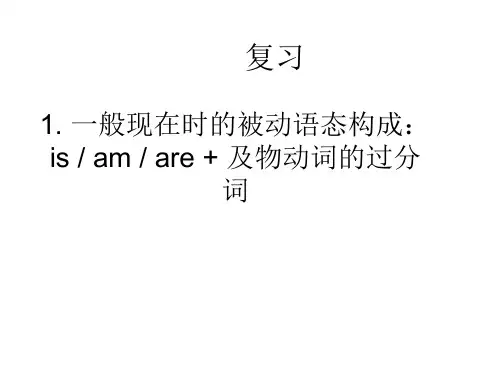
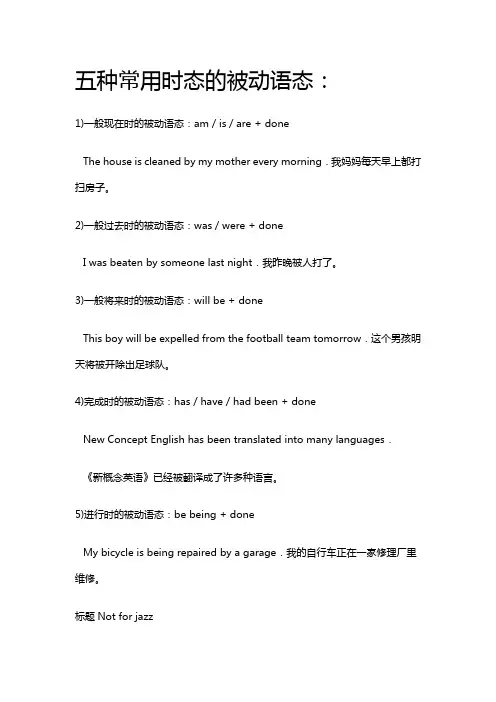
五种常用时态的被动语态:1)一般现在时的被动语态:am/is/are + doneThe house is cleaned by my mother every morning.我妈妈每天早上都打扫房子。
2)一般过去时的被动语态:was/were + doneI was beaten by someone last night.我昨晚被人打了。
3)一般将来时的被动语态:will be + doneThis boy will be expelled from the football team tomorrow.这个男孩明天将被开除出足球队。
4)完成时的被动语态:has/have/had been + doneNew Concept English has been translated into many languages.《新概念英语》已经被翻译成了许多种语言。
5)进行时的被动语态:be being + doneMy bicycle is being repaired by a garage.我的自行车正在一家修理厂里维修。
标题Not for jazz总结for的用法:1)为:I bought a book for you.我为你买了一本书。
2)因为:Something fell in,for I heard a splash.一定有东西掉下去了,因为我听见扑通一声。
4)适合:Not for jazz=It's not suitable to play jazz on the clavichord.古钢琴不适合演奏爵士乐。
Question:What happened to the clavichord?to后面加宾语,表示其身上发生了什么事,即动作的目标、对象。
What happened to you?你怎么了?(在你身上发生了什么事?)(1)否定句与疑问句的被动语态We don’t believe her.我们不信她的话。

动词的被动语态【用法讲解】考试要求:中考要求掌握:动词的主动语态和被动语态区别与使用,不同时态的被动语态形式及情态动词的被动语态形式。
英语动词有两种语态:主动语态和被动语态,主动语态表示句子的主语是谓语动作的执行者;被动语态是表示句子的主语是谓语动作的承受者。
如:We often clean the blackboard.(我们是擦黑板的执行者即主动语态)The blackboard is often cleaned by us. (黑板是clean的承受者即被动语态)。
1. 被动语态的结构一般现在时:am / is / are + 及物动词的过去分词一般过去时:was / were + 及物动词的过去分词一般将来时:will / shall be + 及物动词的过去分词现在完成时:have / has been + 及物动词的过去分词现在进行时:am / is / are being + 及物动词的过去分词过去完成时:had been + 及物动词的过去分词如:You are wanted on the phone. 有你的电话。
China was liberated in 1949. 1949年中国解放。
The problem will be discussed tomorrow.明天将对这个问题进行讨论。
Not a book in the library has been taken away.图书馆里没有一本书被人拿走。
My bike is being repaired.我的自行车正在修理。
The book had been borrowed when I got to the library.我到了图书馆时,那本书已经借出去了。
2. 主动语态与被动语态的转换(1)把主动语态的宾语变为被动语态的主语。
(2)把谓语变成被动结构(be+过去分词),根据被动语态句子里主语的人称和数,以及原来主动语态句子中动词的时态来决定be的形式。

语态篇——常见与不常见的被动[提问]在下面这个句子中,那些部分为被动语态?“I had not originally been scheduled to work this day but I was extremely pleased when I was asked to help out at the last minute, for it would be one of the most memorable days of the games. (Experiencing English Integrated Book Page120)”答:要分析上面这个句子,并划出相应的被动语态部分,首先要清楚地了解什么是被动语态和被动语态的结构。
在语法学中,语态是针对动词而言的一种形式,描述句子中动词和参与此动作的主语之间关系。
语态分为主动Active V oice和被动Passive V oice两种。
当主语是动作的发起者(或之一)时,称为主动语态;如果主语为动作的承受者时,称为被动语态。
例如:“猫吃老鼠。
”这句话是主动语态;而“老鼠被猫吃。
”则是被动语态。
一点意见,我觉得这些语法太简单了被动语态强调动作的对象或动作本身,句中主语是动作的受动者。
分析句子时找到主语和谓语动词,如果主语并非主动行为,而是接受动作,是动作指向的对象,那么该句就是被动句。
被动语态的基本构成为:be动词+及物动词过去分词。
其中be动词随着句子的不同时态发生相应变化,并要注意随主语人称、单复数变化而使用正确形式。
1)一般现在时:am/is/are+V-ed2)一般过去时:was/were+V-ed3)一般将来时:will/shall be+V-ed4)现在进行时:am/is/are being+V-ed5)过去进行时:was / were being + V-ed6)现在完成时:have/has been+V-ed7)过去完成时:had been+V-ed8)将来完成时:shall / will have been + V-ed9)过去将来完成时:would / should have been + V-ed例如:1)All kinds of commodities made in China are widely used in many American families. 这句中文翻译漏了吧。
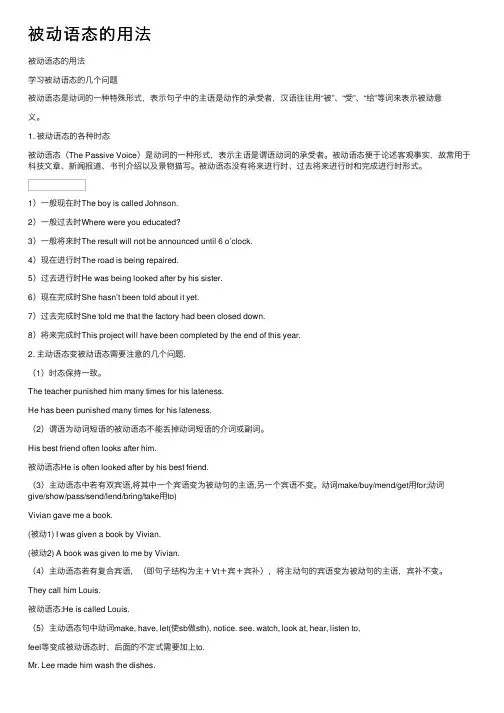
被动语态的⽤法被动语态的⽤法学习被动语态的⼏个问题被动语态是动词的⼀种特殊形式,表⽰句⼦中的主语是动作的承受者,汉语往往⽤“被”、“受”、“给”等词来表⽰被动意义。
1. 被动语态的各种时态被动语态(The Passive Voice)是动词的⼀种形式,表⽰主语是谓语动词的承受者。
被动语态便于论述客观事实,故常⽤于科技⽂章、新闻报道、书刊介绍以及景物描写。
被动语态没有将来进⾏时、过去将来进⾏时和完成进⾏时形式。
1)⼀般现在时The boy is called Johnson.2)⼀般过去时Where were you educated?3)⼀般将来时The result will not be announced until 6 o’clock.4)现在进⾏时The road is being repaired.5)过去进⾏时He was being looked after by his sister.6)现在完成时She hasn’t been told about it yet.7)过去完成时She told me that the factory had been closed down.8)将来完成时This project will have been completed by the end of this year.2. 主动语态变被动语态需要注意的⼏个问题.(1)时态保持⼀致。
The teacher punished him many times for his lateness.He has been punished many times for his lateness.(2)谓语为动词短语的被动语态不能丢掉动词短语的介词或副词。
His best friend often looks after him.被动语态He is often looked after by his best friend.(3)主动语态中若有双宾语,将其中⼀个宾语变为被动句的主语,另⼀个宾语不变。

被动语态一. 概念:表示动作与主语之间是被动关系的句子是被动语态。
二. 主动语态与被动语态之间如何转换三. 各种不同时态的主动语态与被动语态的对比时态主动语态被动语态一般现在时am / is / are + P.P.(1)Do they speak French ?(2)They don’t use the room .Is French spoken by them ?The room isn’t used by them .一般过去时was / were + p.p.(1)The hunter killed a tiger .(2)He wrote many stories last year .A tiger was killed by the hunter .Many stories were written by him last year .四. 如何正确使用被动语态1. 有些动词带有两个宾语,即直接宾语和间接宾语,变被动语态时,可把其中一个宾语变成主语,另一个留在被动结构谓语后面。
需要注意的是:若把直接宾语变成被动语态的主语,需要在间接宾语之间加上介词“to”。
eg. He often tells us interesting stories . (主动语态)The interesting stories are often told to us by him.(被动语态)▲常带双宾语的词有:tell , show , lend , pass等。
2. 在主动语态中,某些动词之后带有复合宾语,即宾语和宾语补足语,这个复合宾语由动词不定式来充当,to被省略,但在被动语态中,这个to还要还原。
eg. I often hear her sing this popular song . (主动语态)She is often heard to sing this popular song .(被动语态)▲有这种用法的常用动词有:make , let , see , hear , watch , feel , notice等。
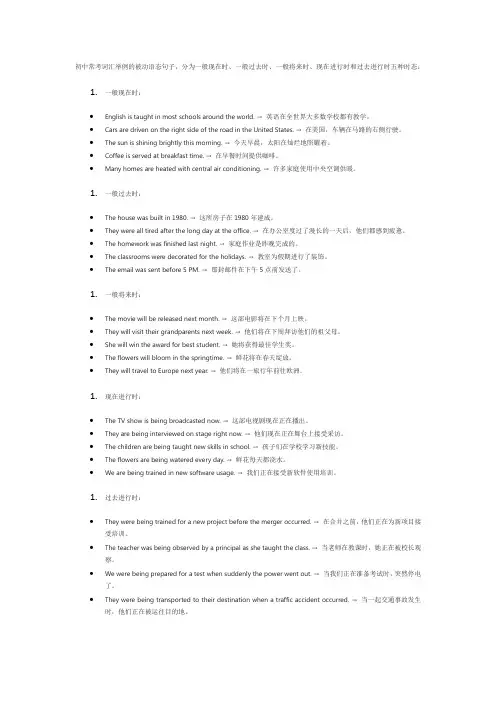
初中常考词汇举例的被动语态句子,分为一般现在时、一般过去时、一般将来时、现在进行时和过去进行时五种时态:1.一般现在时:•English is taught in most schools around the world. → 英语在全世界大多数学校都有教学。
•Cars are driven on the right side of the road in the United States. → 在美国,车辆在马路的右侧行驶。
•The sun is shining brightly this morning. → 今天早晨,太阳在灿烂地照耀着。
•Coffee is served at breakfast time. → 在早餐时间提供咖啡。
•Many homes are heated with central air conditioning. → 许多家庭使用中央空调供暖。
1.一般过去时:•The house was built in 1980. → 这所房子在1980年建成。
•They were all tired after the long day at the office. → 在办公室度过了漫长的一天后,他们都感到疲惫。
•The homework was finished last night. → 家庭作业是昨晚完成的。
•The classrooms were decorated for the holidays. → 教室为假期进行了装饰。
•The email was sent before 5 PM. → 那封邮件在下午5点前发送了。
1.一般将来时:•The movie will be released next month. → 这部电影将在下个月上映。
•They will vi sit their grandparents next week. → 他们将在下周拜访他们的祖父母。

一般现在时和一般过去时被动语态的用法口诀摘要:一、一般现在时被动语态的用法1.构成方法2.常见疑问句与回答3.实际应用举例二、一般过去时被动语态的用法1.构成方法2.常见疑问句与回答3.实际应用举例正文:【一般现在时被动语态的用法】一般现在时被动语态主要用来描述现在的状态、经常发生的事情或事实。
其构成方法为:be + 过去分词。
例如:1.我每天都被老师批评。
"I am criticized by the teacher every day."2.她经常被邀请参加派对。
"She is often invited to the party."3.电脑被很多人使用。
"Computers are used by many people."对于一般现在时的被动语态疑问句,通常使用“Is/Are + 主语+ 过去分词”的形式。
例如:1.你每天都被谁批评?"Who is criticized by you every day?"2.她经常被谁邀请参加派对?"Who is she often invited to the party by?"3.电脑被谁使用?"Who uses computers?"【一般过去时被动语态的用法】一般过去时被动语态用于描述过去发生的动作或状态。
其构成方法为:was/were + 过去分词。
例如:1.我昨天被老师批评了。
"I was criticized by the teacher yesterday."2.她上周被邀请参加派对。
"She was invited to the party last week."3.电脑在过去经常被很多人使用。
"Computers were often used by many people in the past."对于一般过去时的被动语态疑问句,通常使用“Was/Were + 主语+ 过去分词”的形式。
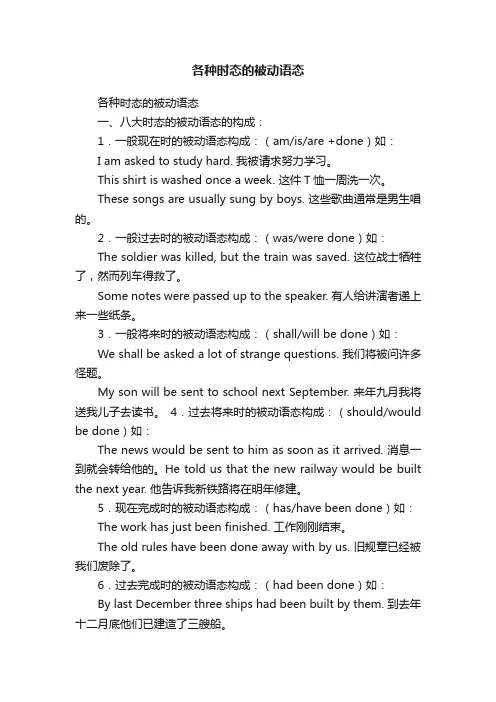
各种时态的被动语态各种时态的被动语态一、八大时态的被动语态的构成:1.一般现在时的被动语态构成:(am/is/are +done)如:I am asked to study hard. 我被请求努力学习。
This shirt is washed once a week. 这件T恤一周洗一次。
These songs are usually sung by boys. 这些歌曲通常是男生唱的。
2.一般过去时的被动语态构成:(was/were done)如:The soldier was killed, but the train was saved. 这位战士牺牲了,然而列车得救了。
Some notes were passed up to the speaker. 有人给讲演者递上来一些纸条。
3.一般将来时的被动语态构成:(shall/will be done)如:We shall be asked a lot of strange questions. 我们将被问许多怪题。
My son will be sent to school next September. 来年九月我将送我儿子去读书。
4.过去将来时的被动语态构成:(should/would be done)如:The news would be sent to him as soon as it arrived. 消息一到就会转给他的。
He told us that the new railway would be built the next year. 他告诉我新铁路将在明年修建。
5.现在完成时的被动语态构成:(has/have been done)如:The work has just been finished. 工作刚刚结束。
The old rules have been done away with by us. 旧规章已经被我们废除了。

被动语态的一般过去时、一般现在时、一般将来时(一)被动语态结构(P assive Voice)结构:be +---am/are /is + 动词的过去分词done情态动词的被动语态---can/must/may/should + be +done主动句与被动句之间的转换(一)主动句变为被动句所遵循的3个步骤:1.宾变主:把原主动句中的宾语变为被动句的主语.2.变被动:把动词变为被动形式即be +过去分词,并注意其人称和数随主语的变化,而动词的时态则保持不变。
3.主变宾+ by:原主动句的主语如需要则放在by后面以它的宾格形式出现(注代词的宾格),如不需要则可省略。
(二)句式转换:将被动句中所带的助动词be, will, have, can, must .......... 后加not 或提到句首.waters the flowers every day.变被动:The flowers否定:The flowersYes,2.He cut the old tree yesterday.一般过去时的被动语态---was/were +done一般将来时的被动语态——will be + done一般现在时的被动语态We bought some books.father every day.father问句及答: the flowers father every day主语谓语动词宾语被动语态变被动:The old tree yesterday.否定: The old tree6. The lazy boy didn't wash clothes yesterday. by the lazy boy yesterday.一般现在时 1He often helps me in English.2Lucy does her homework in the evening.3They make shoes in that factory. you water the flowers every day一般过去时1 We built our school 95 years ago.2They planted many trees last year.3He didn ' t take the photo in 2003. you finish your homework一般将来时1We will hold our National Games in Jinan.问句及答 : the old tree yesterdayNo,3. They will have a class meeting tomorrow.变被动 : A class meeting by them tomorrow. 划线提问 : the class meeting by them4. We should do something to stop the pollution. 变被动:to stop the pollution. 划线提问 :to stop the pollution 5. Do people use Chinese only in China 变被动 :Chinese only in China people变被动 : Clothes2I will invite my teacher to the party.3He won' t finish his homework in an hour.4We must clean the classroom every day.5Parents should allow the teenagers to choose their own clothes.6Uncle Wang can't mend his bike . 含情态动词、谓语动词是由不及物动词加介词或副词构成的。
英语被动语态的用法归纳决定动词用主动语态还是被动语态主要看动词和主语的关系。
如果主语是动作的执行者,也就是说它们是主动关系,此时动词用主动语态;如果主语是动作的承受者,也就是说它们是被动关系,此时动词则用被动语态。
英语的被动语态由“助动词be+过去分词”构成,其中be有时态、人称和数的变化。
被动语态的时态:1.一般现在时的被动语态:am/is/ are +动词的过去分词2.一般过去时的被动语态:was/were +动词的过去分词3.一般将来时的被动语态:will be +动词的过去分词4.现在进行时的被动语态:am/is/are +being +动词的过去分词5.现在完成时的被动语态:have/has +been +动词的过去分词6.情态动词的被动语态:情态动词+ be +动词的过去分词被动语态的基本用法:(1)需要强调动作的承受者时The Great Wall is enjoyed by millions of people all over the world.English is widely spoken in the world now.(2)不知道或没必要指出动作的执行者时Mr.Wang is invited to the meeting today.The problem is dealt with now.(3)当说话人需要强调客观时It is said that she was a beauty when she was young主动语态变被动语态的变法:宾变主,主变宾,谓变be done ,时不变,数格必须随被变。
注:1.主动、被动的时态要一致。
2.主动、被动的句式要一致。
3.变成的被动语态的主语与谓语在单复数上保持一致。
一般过去时被动语态基本句式(1)肯定式:主语+ was/were +过去分词+by?It was made in Beijing Ren'ai Education Institute.(2)否定式:主语+was/were + not +过去分词+ by?She was not given a paniting by him.This question was not discussed at the meeting yesterday.(3)一般疑问句:Was/Were+主语+过去分词+by?Was it made of bamboo?(4)特殊疑问句:特殊疑+was/were+过去分词+by?What was it made of?特殊情况的被动语态:1.带双宾语的被动语态:动词+ sb(间宾)+sth(直宾)口诀:如遇双宾语,一般变间宾,若把直宾变,to/for间宾连。
被动语态
一. 概念:表示动作与主语之间是被动关系的句子是被动语
态。
二. 主动语态与被动语态之间如何转换
三. 各种不同时态的主动语态与被动语态的对比
时态主动语态被动语态
一般现在时
am / is / are + P.P.
(1)Do they speak French ?
(2)They don’t use the room .
Is French spoken by them ?
The room isn’t used by them .
一般过去时
was / were + p.p.
(1)The hunter killed a tiger .
(2)He wrote many stories last year .
A tiger was killed by the hunter .
Many stories were written by him last year .
四. 如何正确使用被动语态
1. 有些动词带有两个宾语,即直接宾语和间接宾语,变被动语态时,可把其中一个宾语变成主
语,另一个留在被动结构谓语后面。
需要注意的是:若把直接宾语变成被动语态的主语,需要在间接宾语之间加上介词“to”。
eg. He often tells us interesting stories . (主动语态)
The interesting stories are often told to us by him.(被动语态)
▲常带双宾语的词有:tell , show , lend , pass等。
2. 在主动语态中,某些动词之后带有复合宾语,即宾语和宾语补足语,这个复合宾语由动词不
定式来充当,to被省略,但在被动语态中,这个to还要还原。
eg. I often hear her sing this popular song . (主动语态)
She is often heard to sing this popular song .(被动语态)
▲有这种用法的常用动词有:make , let , see , hear , watch , feel , notice等。
3. 有些“be +过去分词”的结构并不是被动语态,它们有可能是“系表结构(即系动词之后由过
去分词来充当表语)。
”区别是被动语态强调动作,系表结构强调状态。
比较:(1)The shop is often closed at 6∶30 in the afternoon. (带,是被动语态)。